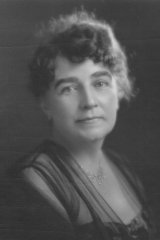Women’s History Month: Women of Today Working Toward a Better Tomorrow
Women have long been the catalysts for social change, and the environmental movement is no exception.
From Rachel Carson to Jane Goodall to Wangari Maathai, women have made groundbreaking contributions to science, conservation, and environmental protection.
And there are many more women who have made an impact on our country’s environmental legacy. Women like Gene Stratton-Porter (a fellow Hoosier, like me!).

Gene (short for Geneva) was a self-taught American author, nature photographer, and naturalist from northeast Indiana. She wrote best-selling novels in the early 1900s, like The Girl of the Limberlost. A number of silent movies were made from her books; but when she didn’t care for those productions, she founded her own production company. Gene hyphenated her last name, wore pants as she tromped around the swamp collecting plants, and encouraged people to explore the outdoors.
Decades before Rachel Carson and many other scientists, Gene recognized the impact that cutting down trees and draining the Limberlost swamp would have on climate change and encouraged Americans to preserve the environment. She also realized the impact that her words and her own independent actions could have on the women—like me—who followed in her footsteps.
We admire women like Rachel Carson and Gene Stratton-Porter—women who will go down in history for the contributions they have made. But look at the women all around you—every one of us can make a difference.
It’s the mothers and grandmothers who protect and teach our children and grandchildren. It’s the teachers, coaches, and camp counselors that give each of us a small window into what our earth has to offer and why it is so important to protect what she has given to us.
It’s Kamala Harris, the first woman—and first woman of color—to ever serve as Vice President.
It’s countless women who give girls across this country someone to look up to and think “that could be me.”
At EPA, women are working every day to secure a more sustainable, more equitable environment that will support future generations for years to come. I am honored and proud to serve at an agency that strives to ensure that every single woman’s voice is heard—no matter the color of her skin, her sexual orientation, or her ability or disability—and that our decision-making is informed by a diversity of perspectives.
When I started my journey in state government in Massachusetts, I had no idea where my career would take me. I could have never imagined all the incredible women I would meet along the way or all the hard work we would undertake to save lives and improve air and water quality across this great nation.
Serving as Deputy Administrator is the honor of my life. While I never could have imagined this role for myself, if my path and my career can inspire just one little girl to chase and accomplish her wildest hopes and dreams, then I will have done my job to put one more small crack in the glass ceiling that has held women back and down for far too long.
Occasions like Women’s History Month allow us to pause and think about the particular contributions that women have made through history and are making every day at EPA. The women of EPA are serving the public every day, in every imaginable role.
But it’s the work we all do together—women and men—at EPA that helps secure a healthier, cleaner future for all.

About the Author
Janet McCabe
Deputy Administrator
Office of the Administrator
Janet McCabe was sworn in as the 16th Deputy Administrator of the United States Environmental Protection Agency on April 29, 2021. Deputy Administrator McCabe returns to EPA after spending seven years working as Acting Assistant Administrator and Principal Deputy to the Assistant Administrator in the Office of Air and Radiation under President Barack Obama.
Prior to rejoining EPA, Janet McCabe was a Professor of Practice at the Indiana University McKinney School of Law and Director of the IU Environmental Resilience Institute, where she started as Assistant Director for Policy and Implementation in 2017. Her work at Indiana University centered on establishing innovative, research-informed, and actionable solutions to reduce environmental risks and help protect the health of communities and families.
McCabe knows firsthand that programs to improve public health and protect our environment are strongest when they are informed by a diversity of perspectives, and rooted in science, transparency, and the law.
Editor’s Note: The views expressed here are intended to explain EPA policy. They do not change anyone’s rights or obligations. You may share this article. However, please do not change the title or the content, or remove EPA’s identity as the author. If you do make substantive changes, please do not attribute the edited title or content to EPA or the author.
EPA’s official web site is www.epa.gov. Some links on this page may redirect users from the EPA website to specific content on a non-EPA, third-party site. In doing so, EPA is directing you only to the specific content referenced at the time of publication, not to any other content that may appear on the same webpage or elsewhere on the third-party site, or be added at a later date.
EPA is providing this link for informational purposes only. EPA cannot attest to the accuracy of non-EPA information provided by any third-party sites or any other linked site. EPA does not endorse any non-government websites, companies, internet applications or any policies or information expressed therein.
